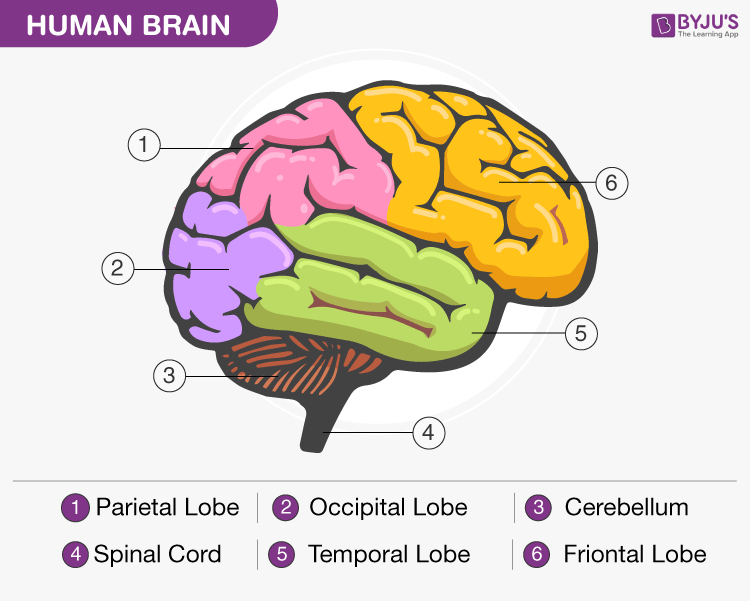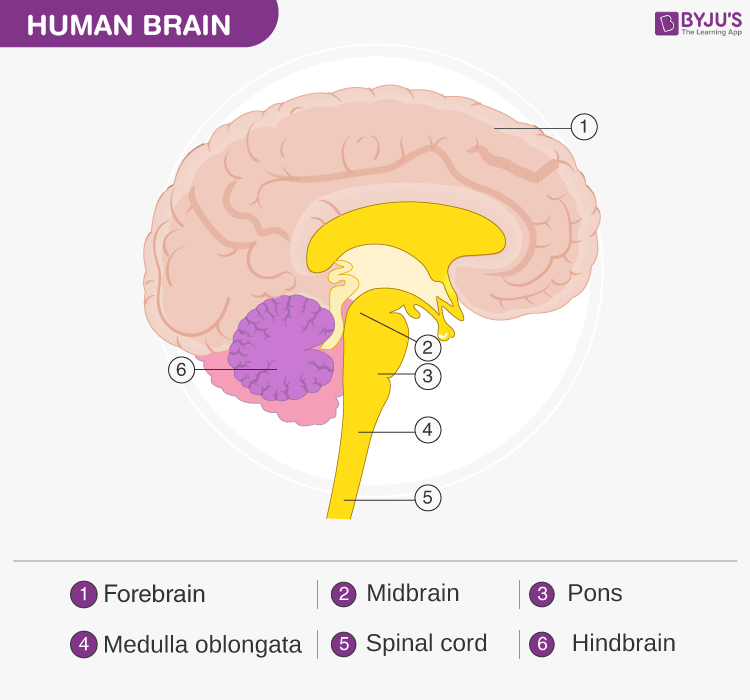The human brain controls nearly every aspect of the human body ranging from physiological functions to cognitive abilities. It functions by receiving and sending signals via neurons to different parts of the body. The human brain, just like most other mammals, has the same basic structure, but it is better developed than any other mammalian brain.
Table of Contents
Read on to explore the human brain structure, diagram, parts of the human brain and the body functions controlled by the human brain.
Also Read: Placebo effect
Find out how some people live with just half a brain.

The Human Brain
On average, an adult brain weighs between 1.0 kg – 1.5 kg. It is mainly composed of neurons – the fundamental unit of the brain and nervous system. Recent estimates have suggested that the brain contains anywhere between 86 billion to 100 billion neurons.
The brain, along with the spinal cord, constitutes the central nervous system. It is responsible for thoughts, interpretation and origin of control for body movements.
Read More: Central Nervous System
Brain Diagram
The brain diagram given below highlights the different lobes of the human brain.

Where is the Brain located?
The brain is enclosed within the skull, which provides frontal, lateral and dorsal protection. The skull consists of 22 bones, 14 of which form the facial bones and the remaining 8 form the cranial bones. Anatomically, the brain is contained within the cranium and is surrounded by the cerebrospinal fluid.
The Cerebrospinal Fluid (CSF) is a fluid that circulates within the skull and spinal cord, filling up hollow spaces on the surface of the brain. Every day, the specialised ependymal cells produce around 500mL of cerebrospinal fluid.
The primary function of the CSF is to act as a buffer for the brain, cushioning mechanical shocks and dampening minor jolts. It also provides basic immunological protection to the brain.
Furthermore, CSF provides buoyancy for the brain. i.e., the brain is suspended in a layer of CSF, wherein, the weight of the brain is nearly negated. If the brain is not suspended in CSF, it would be impeded by its weight, consequently cutting off the blood supply in the lower half of the brain. It would lead to the death of neurons in the affected area.
Also Read: Neurons – Nerve Impulses
Parts of Human Brain
Following are the major parts of the human brain:
Forebrain – Largest part of the brain
It is the anterior part of the brain. The forebrain parts include:
- Cerebrum
- Hypothalamus
- Thalamus
Forebrain Function: Controls the reproductive functions, body temperature, emotions, hunger and sleep.
Fact: The largest among the forebrain parts is the cerebrum. It is also the largest part of all vertebrate brains.
Midbrain: Smallest and central part of the brain
The midbrain consists of:
- Tectum
- Tegmentum
Hindbrain: The lower part of the brain
The hindbrain is composed of:
- Cerebellum
- Medulla
- Pons
Hindbrain functions: The three regions of the hindbrain coordinates all processes necessary for survival. These induce breathing, heartbeat, sleep, wakefulness and motor learning.

Brain diagram highlighting various parts of the human brain
Cerebrum
The cerebrum is the largest part of the brain. It consists of the cerebral cortex and other subcortical structures. It is composed of two cerebral hemispheres that are joined together by heavy, dense bands of fibre called the corpus callosum. The cerebrum is further divided into four sections or lobes:
-
Frontal lobe: It is associated with parts of speech, planning, reasoning, problem-solving and movements.
-
Parietal lobe: Help in movements, the perception of stimuli and orientation.
-
Occipital lobe: It is related to visual processing.
-
Temporal lobe: This region is related to perception and recognition of memory, auditory stimuli and speech.
The brain consists of two types of tissues: Grey matter and White matter.
- Grey matter mainly consists of various types of cells, which make up the bulk of the brain.
- White matter is primarily composed of axons, which connect various grey matter areas of the brain with each other.
The exterior portion of the cerebrum is called the cortex or the cerebral mantle. The cortex is extremely convoluted, due to which, it has a large surface area. The cerebrum also includes:
-
Sensory areas: To receive the messages.
-
Association areas: These areas integrate the incoming sensory information. It also forms a connection between sensory and motor areas.
-
Motor areas: This area is responsible for the action of the voluntary muscles.
Cerebrum Function
The cerebrum is responsible for thinking, intelligence, consciousness and memory. It is also responsible for interpreting touch, hearing and vision.
Thalamus
The thalamus is a small structure, located right above the brain stem responsible for relaying sensory information from the sense organs. It is also responsible for transmitting motor information for movement and coordination. Thalamus is found in the limbic system within the cerebrum. This limbic system is mainly responsible for the formation of new memories and storing past experiences.
Hypothalamus
The hypothalamus is a small and essential part of the brain, located precisely below the thalamus. It is considered the primary region of the brain, as it is involved in the following functions:
- Receives impulses
- Regulates body temperature
- Controls the mood and emotions
- Controls the sense of taste and smell
- Synthesises the body’s essential hormones
- Coordinates the messages from the autonomous nervous system
- Controls appetite, peristalsis, the rate of heartbeat, and blood pressure
- Forms an axis with the pituitary gland which is the main link between the nervous and the endocrine systems
Explore More: Hypothalamus
Tectum
The tectum is a small portion of the brain, specifically the dorsal part of the midbrain. It serves as a relay centre for the sensory information from the ears to the cerebrum. It also controls the reflex movements of the head, eye and neck muscles. It provides a passage for the different neurons moving in and out of the cerebrum.
Tegmentum
Tegmentum is a region within the brainstem. It is a complex structure with various components, which is mainly involved in body movements, sleep, arousal, attention, and different necessary reflexes. It forms the platform for the midbrain and connects with the thalamus, cerebral cortex and the spinal cord.
Cerebellum
The cerebellum is the second largest part of the brain, located in the posterior portion of the medulla and pons. The cerebellum and cerebrum are separated by cerebellar tentorium and transverse fissure. Cortex is the outer surface of the cerebellum, and its parallel ridges are called the folia. Apart from this, the cerebellum has the cerebellar peduncles, cerebellar nuclei, anterior and posterior lobes. The cerebellum consists of two hemispheres, the outer grey cortex and the inner white medulla. It is mainly responsible for coordinating and maintaining the body balance during walking, running, riding, swimming, and precision control of the voluntary movements. The main functions of the cerebellum include:
- It senses equilibrium.
- Transfers information.
- Coordinates eye movement.
- It enables precision control of the voluntary body movements.
- Predicts the future position of the body during a particular movement.
- Both anterior and posterior lobes are concerned with the skeletal movements.
- The cerebellum is also essential for making fine adjustments to motor actions.
- Coordinates and maintains body balance and posture during walking, running, riding, swimming.
Explore: Differences between Cerebellum and Cerebrum
Medulla Oblongata
The medulla oblongata is a small structure present in the lowest region of the brain. It mainly controls the body’s autonomic functions such as heartbeat, breathing, and digestion. It plays a primary role in connecting the spinal cord, pons and the cerebral cortex. Also, it helps us in maintaining our posture and controlling our reflexes.
Pons
The pons is the primary structure of the brain stem present between the midbrain and medulla oblongata. It serves as a relay signals between the lower cerebellum, spinal cord, the midbrain, cerebrum and other higher parts of the brain. The main functions of the pons include:
- Controlling sleep cycles.
- Regulating the magnitude and frequency of the respiration.
- Transfers information between the cerebellum and motor cortex.
- Pons is also involved in sensations, such as the sense of taste, hearing and balance.
Further Reading: Interesting Facts about the Brain
To explore more about the human brain, parts of the human brain, its functions, brain diagram or any other related concept, please visit BYJU’S Biology
Frequently Asked Questions
1. Explain how the nervous system is classified.
The nervous system in humans can be broadly classified into two types, namely, the peripheral nervous system and central nervous system
2. Describe the Central Nervous System.
The central nervous system primarily consists of the brain and the spinal cord. The system coordinates and controls various aspects of life, ranging from physical attributes (heartbeat, breathing) to mental capabilities (memory, intelligence).
3. Explain the Peripheral Nervous System.
The nerves and ganglia that are present outside the brain and spinal cord contribute to the peripheral nervous system. The primary role of the PNS is to connect the central nervous system to the rest of the body, such as the limbs, skin.
4. How is the brain protected in the body?
The brain is enclosed within the skull, where it is suspended in a layer of fluid called the cerebrospinal fluid. It protects the brain from minor mechanical shocks and jolts. Furthermore, it also serves minor immunological roles and provides the necessary nutrients required by the brain.
5. Briefly explain the parts of the brain.
Anatomically, the brain consists of the following parts:
- Forebrain
- Cerebrum,
- Hypothalamus
- Thalamus
- Midbrain
- Tectum
- Tegmentum
- Hindbrain
- Cerebellum
- Medulla
- Pons

Very helpful to study complex topics
this was a very helpful notes and questions for the preparation for class 10.
It’s very useful to understand some difficult topics
very useful notes for study.
thank you
Fantastic study material
Super very interesting
Thank you byjus very helpful for me?
Very good
Very amazing ? topic
Nice to study.
so interesting
Nice content very useful for reading
Supper.
Thank you so much.
Really, this is a very good note.
And it is very helpful for me.
Interesting and mind-blowing. Extraordinary????
Thank you this site was very useful for my project ?and I’ll look forward to taking all kinds of information from here
VERY NICE .THANK YOU .
Thank you, it was very useful. ?
very helpful I understand each and every thing thanks sir
good lesson
Nice concept, it is amazing and we can read it very easily???????????
Very helpful!! Would surely recommend
very helpful notes thank you very much
VERY HELPFUL NOTES AND THANKS.
Byjus is very good, answering all questions
This is very interesting thank you so much
I AM VERY GRATEFUL TO HAVE BYJU’S IN THIS WORLD FOR HELPING ME WITH MY STUDIES
I like t way you teach but I think that you should also provide the whatsapp quary assistance also otherwise it is good keep it up????????